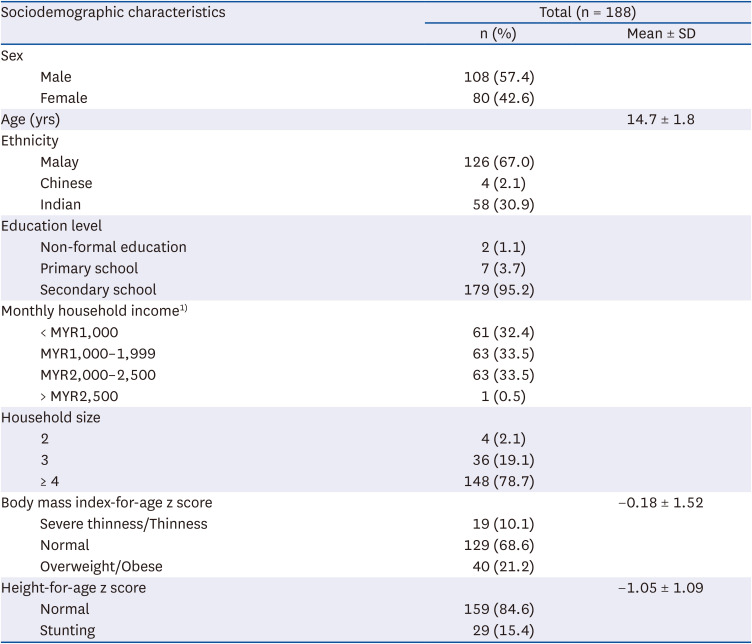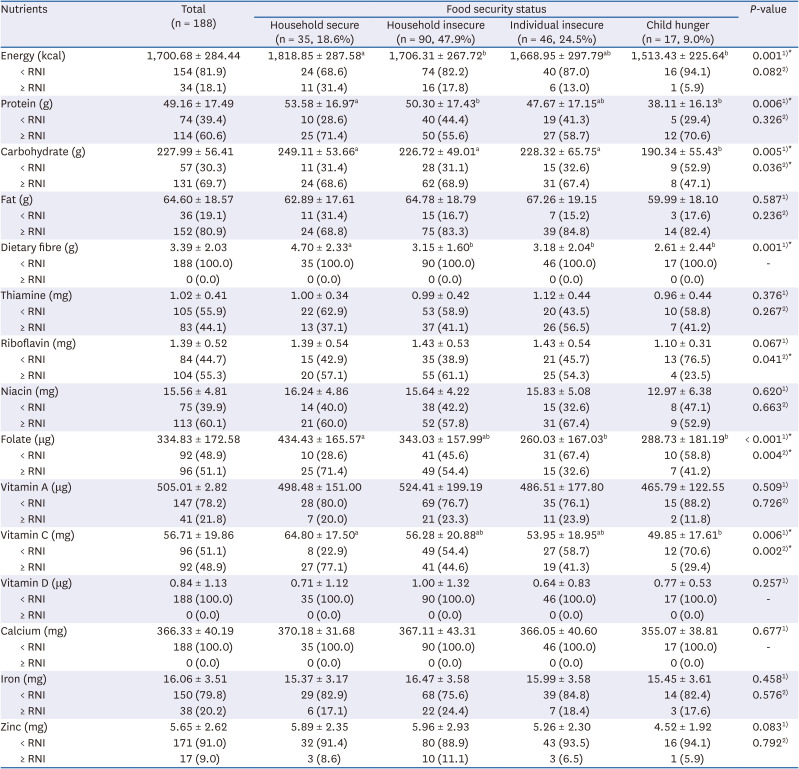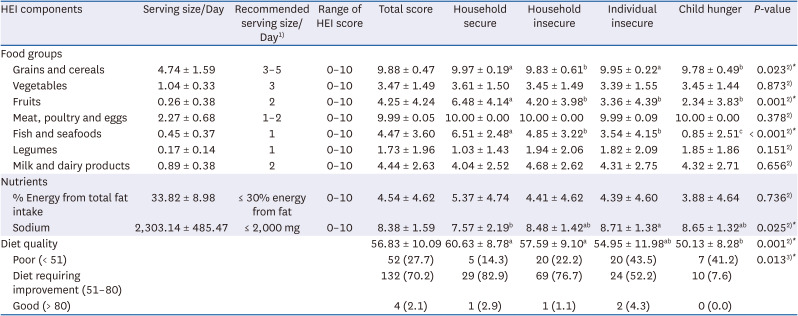1. World Health Organization (WHO). The Global Strategy for Women’s, Children’s, and Adolescents’ Health (2016-2030). New York (NY): Every Woman Every Child;2015.
2. Ihab A, Rohana A, Manan WW. Concept and measurements of household food insecurity and its impact on malnutrition: a review. Int Med J. 2015; 22:509–516.
3. Peng W, Berry EM. The concept of food security. Ferranti P, Berry EM, Anderson JR, editors. Encyclopedia of Food Security and Sustainability. Amsterdam: Elsevier;2019. p. 1–7.
4. Food and Agriculture Organization (FAO). The State of Food Insecurity in the World 2001. Rome: FAO;2002.
5. Zezza A, Tasciotti L. Urban agriculture, poverty, and food security: empirical evidence from a sample of developing countries. Food Policy. 2010; 35:265–273.
6. United Nations Children's Fund (UNICEF). Children Without: A Study of Urban Child Poverty and Deprivation in Low-Cost Flats in Kuala Lumpur. Putrajaya: UNICEF;2018.
7. Institute for Public Health (MY). National Health and Morbidity Survey (NHMS) 2017: Adolescent Nutrition Survey. Putrajaya: Ministry of Health;2017.
8. Kirkpatrick SI, McIntyre L, Potestio ML. Child hunger and long-term adverse consequences for health. Arch Pediatr Adolesc Med. 2010; 164:754–762. PMID:
20679167.
9. Utter J, Denny S, Robinson E, Teevale T, Crengle S, Ameratunga S, Fleming T. Food security concerns among young people: impact on eating behaviors and weight status. J Hunger Environ Nutr. 2012; 7:101–111.
10. Fram MS, Ritchie LD, Rosen N, Frongillo EA. Child experience of food insecurity is associated with child diet and physical activity. J Nutr. 2015; 145:499–504. PMID:
25733465.
11. Moradi S, Mirzababaei A, Mohammadi H, Moosavian SP, Arab A, Jannat B, Mirzaei K. Food insecurity and the risk of undernutrition complications among children and adolescents: a systematic review and meta-analysis. Nutrition. 2019; 62:52–60. PMID:
30852458.
12. Maitra C. A Review of Studies Examining the Link Between Food Insecurity and Malnutrition. Technical Paper. Rome: Food and Agriculture Organization (FAO);2018.
13. Kim HJ, Oh K. Household food insecurity and dietary intake in Korea: results from the 2012 Korea National Health and Nutrition Examination Survey. Public Health Nutr. 2015; 18:3317–3325. PMID:
25828606.
14. Alie S, Sulaiman N, Nor FM, Mesbah SF. Demographic factors, food security, health-related quality of life and body weight status of adolescents in rural area in Mentakab, Pahang, Malaysia. Malays J Nutr. 2019; 25:297–307.
15. Ya RM, Bakar WA, Afandi A, Ab Rahman J, Shariff ZM. Food security status and childhood obesity in Kuantan Pahang. Int J Allied Health Sci. 2017; 1:56–71.
16. Ahmad MH, Selamat R, Salleh R, Majid NL, Zainuddin AA, Bakar WA, Aris T. Food insecurity situation in Malaysia: findings from Malaysian Adult Nutrition Survey (MANS) 2014. Malays J Public Health Med. 2020; 20:167–174.
17. Pei CS, Appannah G, Sulaiman N. Household food insecurity, diet quality, and weight status among indigenous women (Mah Meri) in Peninsular Malaysia. Nutr Res Pract. 2018; 12:135–142. PMID:
29629030.
18. United Nations (UN). General Assembly Resolution 70/1. Transforming Our World: The 2030 Agenda for Sustainable Development. A/RES/70/1. New York (NY): UN;2015.
19. Daniel WW. Biostatistics: A Foundation for Analysis in the Health Sciences. 7th ed. New York (NY): Wiley;1999.
20. Selamat R, Ahmad H, Lin CZ, Zainuddin AA, Shariff ZM, Bakar WA. Household food insecurity in Malaysia: findings from Malaysian Adults Nutrition Survey. Med J Malaysia. 2015; 70:11.
21. Radimer KL, Olson CM, Greene JC, Campbell CC, Habicht JP. Understanding hunger and developing indicators to assess it in women and children. J Nutr Educ. 1992; 24:36S–44S.
22. de Onis M, Onyango AW, Borghi E, Siyam A, Nishida C, Siekmann J. Development of a WHO growth reference for school-aged children and adolescents. Bull World Health Organ. 2007; 85:660–667. PMID:
18026621.
23. Tee ES, Ismail MN, Nasir MA, Khatijah I. Nutrient Composition of Malaysian Foods. Malaysian Food Composition Database Programme. Kuala Lumpur: Institute for Medical Research;1997.
24. Ministry of Health Malaysia. National Coordinating Committee on Food and Nutrition (NCCFN). Recommended Nutrient Intakes for Malaysia: A Report of the Technical Working Group on Nutritional Guidelines. Putrajaya: Ministry of Health Malaysia;2017.
25. Goh HW, Norimah AK. Validation of Healthy Eating Index (HEI) for Malaysian adults. In : Proceedings of 27th Scientific Conference of the Nutrition Society of Malaysia; 2012 May 24–25; Kuala Lumpur, Malaysia. Selangor: Nutrition Society of Malaysia;2012. p. 139.
26. Lee TT, Norimah AK, Safiah MY. Development of Healthy Eating Index for Malaysian adults. In : Proceedings of 26th Scientific Conference of the Nutrition Society of Malaysia; 2011 Mar 24–25; Kuala Lumpur, Malaysia. Selangor: Nutrition Society of Malaysia;2011. p. 24–25.
28. George D, Mallery M. SPSS for Windows Step by Step: A Simple Guide and Reference, 17.0 Update. 10th ed. Boston (MA): Pearson;2010.
29. Chang AP. Does household food insecurity reflects diet quality of children? A study among the B40 families in Pendang, Kedah. UMT J Undergrad Res. 2020; 2:47–54.
30. Farhadian A, Chan VS, Farhadian H, Farhadian H. Addressing household food insecurity using the household food insecurity access scale (HFIAS) in a poor rural community in Sabah, Malaysia. Int J Humanit Soc Sci Invent. 2015; 4:89–100.
31. Ali Naser I, Jalil R, Wan Muda WM, Wan Nik WS, Mohd Shariff Z, Abdullah MR. Association between household food insecurity and nutritional outcomes among children in Northeastern of Peninsular Malaysia. Nutr Res Pract. 2014; 8:304–311. PMID:
24944776.
32. Azizan NA, Thangiah N, Su TT, Majid HA. Does a low-income urban population practise healthy dietary habits? Int Health. 2018; 10:108–115. PMID:
29462331.
33. Abdul Majid H, Ramli L, Ying SP, Su TT, Jalaludin MY, Abdul Mohsein NA. Dietary intake among adolescents in a middle-income country: an outcome from the Malaysian Health and Adolescents Longitudinal Research Team Study (the MyHeARTs Study). PLoS One. 2016; 11:e0155447. PMID:
27187889.
34. Daud NM, Fadzil NI, Yan LK, Makbul IAA, Yahya NFS, Teh AH, Rahman HA. Knowledge, attitude and practice regarding dietary fibre intake among Malaysian rural and urban adolescents. Malays J Nutr. 2018; 24:77–88.
35. Kamar M, Evans C, Hugh-Jones S. Factors influencing adolescent whole grain intake: a theory-based qualitative study. Appetite. 2016; 101:125–133. PMID:
26921485.
36. Moreno LA, Gottrand F, Huybrechts I, Ruiz JR, González-Gross M, DeHenauw S. HELENA Study Group. Nutrition and lifestyle in european adolescents: the HELENA (Healthy Lifestyle in Europe by Nutrition in Adolescence) study. Adv Nutr. 2014; 5:615S–23S. PMID:
25469407.
37. Lopes TS, Sichieri R, Salles-Costa R, Veiga GV, Pereira RA. Family food insecurity and nutritional risk in adolescents from a low-income area of Rio de Janeiro, Brazil. J Biosoc Sci. 2013; 45:661–674. PMID:
23149069.
38. Im JG, Kim SH, Lee GY, Joung H, Park MJ. Inadequate calcium intake is highly prevalent in Korean children and adolescents: the Korea National Health and Nutrition Examination Survey (KNHANES) 2007-2010. Public Health Nutr. 2014; 17:2489–2495. PMID:
24160303.
39. Wallace TC, Bailey RL, Lappe J, O’Brien KO, Wang DD, Sahni S, Weaver CM. Dairy intake and bone health across the lifespan: a systematic review and expert narrative. Crit Rev Food Sci Nutr. 2021; 61:3661–3707. PMID:
32924543.
40. Sioen I, Matthys C, De Backer G, Van Camp J, Henauw SD. Importance of seafood as nutrient source in the diet of Belgian adolescents. J Hum Nutr Diet. 2007; 20:580–589. PMID:
18001379.
41. Khor GL, Shariff ZM, Sariman S, Huang SLM, Mohamad M, Chan YM, Yusof BNM. Milk drinking patterns among Malaysian urban children of different household income status. J Nutr Health Sci. 2015; 2:105.
42. Chee WS, Chang CY, Arasu K, Wong SY, Ong SH, Yang WY, Chong MH, Mavinkurve M, Khoo EJ, Chinna K, et al. Vitamin D status is associated with modifiable lifestyle factors in pre-adolescent children living in urban Kuala Lumpur, Malaysia. Nutrients. 2021; 13:2175. PMID:
34202743.
43. Smith TJ, Tripkovic L, Lanham-New SA, Hart KH. Vitamin D in adolescence: evidence-based dietary requirements and implications for public health policy. Proc Nutr Soc. 2018; 77:292–301. PMID:
29198201.
44. Sinbad OO, Folorunsho AA, Olabisi OL, Ayoola OA, Temitope EJ. Vitamins as antioxidants. J Food Sci Nutr Res. 2019; 2:214–235.
45. Johnson CR, Fischer PR, Thacher TD, Topazian MD, Bourassa MW, Combs GF Jr. Thiamin deficiency in low- and middle-income countries: Disorders, prevalences, previous interventions and current recommendations. Nutr Health. 2019; 25:127–151. PMID:
30798767.
46. Rezali FW, Chin YS, Mohd Yusof BN. Obesity-related behaviors of Malaysian adolescents: a sample from Kajang district of Selangor state. Nutr Res Pract. 2012; 6:458–465. PMID:
23198026.
47. Abbaspour N, Hurrell R, Kelishadi R. Review on iron and its importance for human health. J Res Med Sci. 2014; 19:164–174. PMID:
24778671.
48. Appannah G, Emi NA, Yusin NA, Gan WY, Shariff ZM, Shamsuddin NH, Zaini AA, Appukutty M. Evaluation of dietary quality using Malaysian healthy eating index and its relationships with cardiometabolic risk factors in Malaysian adolescents. Malaysian J Med Health Sci. 2020; 16:46–55.
49. Rezali FW, Chin YS, Mohd Shariff Z, Mohd Yusof BN, Sanker K, Woon FC. Evaluation of diet quality and its associated factors among adolescents in Kuala Lumpur, Malaysia. Nutr Res Pract. 2015; 9:511–516. PMID:
26425281.
50. Eng CW, Lim SC, Ngongo C, Sham ZH, Kataria I, Chandran A, Mustapha FI. Dietary practices, food purchasing, and perceptions about healthy food availability and affordability: a cross-sectional study of low-income Malaysian adults. BMC Public Health. 2022; 22:192. PMID:
35090429.
51. High Level Panel of Experts on Food Security and Nutrition (HLPE). Nutrition and Food Systems. A Report by the High Level Panel of Experts on Food Security and Nutrition of the Committee on World Food Security. Rome: HLPE;2017.
52. Cynthia J, Zalilah MS, Lim MY. Relationship between family meals away from home and nutritional status of adolescents. Malays J Nutr. 2013; 19:25–35. PMID:
24800382.
53. Leyvraz M, Chatelan A, da Costa BR, Taffé P, Paradis G, Bovet P, Bochud M, Chiolero A. Sodium intake and blood pressure in children and adolescents: a systematic review and meta-analysis of experimental and observational studies. Int J Epidemiol. 2018; 47:1796–1810. PMID:
29955869.
54. Nakitto M, Asano K, Choi I, Yoon J. Dietary intakes of adolescents from food insecure households: analysis of data from the 6
th (2013-2015) Korea National Health and Nutrition Examination Survey. Nutr Res Pract. 2017; 11:507–516. PMID:
29209462.
55. Ihab AN, Rohana AJ, Manan WW, Suriati WW, Zalilah MS, Rusli AM. Food expenditure and diet diversity score are predictors of household food insecurity among low income households in rural district of Kelantan Malaysia. Pak J Nutr. 2012; 11:869–875.
56. Mohamadpour M, Sharif ZM, Keysami MA. Food insecurity, health and nutritional status among sample of palm-plantation households in Malaysia. J Health Popul Nutr. 2012; 30:291–302. PMID:
23082631.
57. Huet C, Rosol R, Egeland GM. The prevalence of food insecurity is high and the diet quality poor in Inuit communities. J Nutr. 2012; 142:541–547. PMID:
22323760.
58. Leung CW, Epel ES, Ritchie LD, Crawford PB, Laraia BA. Food insecurity is inversely associated with diet quality of lower-income adults. J Acad Nutr Diet. 2014; 114:1943–1953.e2. PMID:
25091796.
59. Yeh CW, Lo YC, Chen YC, Chen WC, Huang YC. Perceived food insecurity, dietary quality, and unfavorable food intake among children and adolescents from economically disadvantaged households. Nutrients. 2021; 13:3411. PMID:
34684412.
60. Vilar-Compte M, Burrola-Méndez S, Lozano-Marrufo A, Ferré-Eguiluz I, Flores D, Gaitán-Rossi P, Teruel G, Pérez-Escamilla R. Urban poverty and nutrition challenges associated with accessibility to a healthy diet: a global systematic literature review. Int J Equity Health. 2021; 20:40. PMID:
33472636.







 PDF
PDF Citation
Citation Print
Print




 XML Download
XML Download